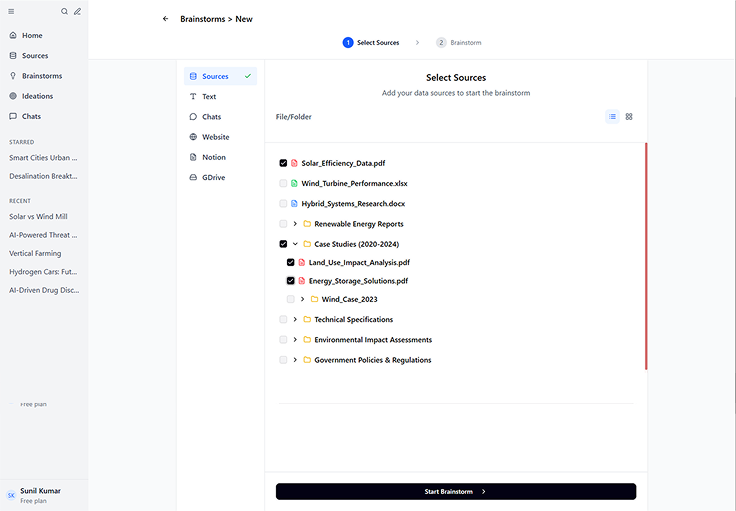Research Hub
Design

Overview
Research Hub is an advanced AI RAG/LLM platform built for researchers, founders, and innovators to turn raw information into actionable concepts.
The platform centralizes research, brainstorming, and idea validation into one intelligent workspace — powered by Retrieval-Augmented Generation (RAG) and Large Language Models (LLMs).
I designed the complete UI/UX system to make complex multi-source research feel fluid, visual, and creatively inspiring.
The Challenge
Traditional research tools force users to switch constantly between documents, websites, and brainstorming apps — creating friction and loss of focus.
The main challenge was to design a unified experience where users could collect sources, analyze data, brainstorm ideas, and export well-structured business concepts — all within one intuitive flow.
My Design Approach
I mapped the entire researcher journey — from sourcing information to generating validated ideas — and broke it down into clear, guided stages.
The design centers around progressive clarity: simple onboarding, smart data organization, and contextual AI assistance at every step.
Each interface was prototyped to reduce cognitive load, ensure visibility of context, and maintain creative momentum even when handling large volumes of data.
Design System & Key Highlights
- Source Aggregation Hub: Users can import research from uploaded files, folders, Notion, Google Drive, or CSV-based website lists — or manually add text and existing chat sessions for deeper LLM context.
- AI-Driven Brainstorming: After selecting sources, users can refine their prompts through optional guiding questions that sharpen the AI’s focus.
- Concept Generator: Outputs fully structured concepts including Overview, Elevator Pitch, Ideal Customer Profile, Problem Statement, Porter’s Five Forces, Business Model Canvas, Value Proposition Canvas, and Top Questions.
- Visual Workspace: Clean, grid-based interface with collapsible panels and status indicators for each stage — from sourcing to export.
- My Role: End-to-end design including user research, UX flow architecture, high-fidelity UI design, and prototype interactions.
Results
User testing showed strong engagement and satisfaction among innovation teams.
Participants reported reduced research time and described the experience as “organized, inspiring, and surprisingly human.”
Research Hub successfully transformed a complex, multi-step research process into a seamless creative workflow — combining analytical precision with ideation fluidity.
Reflection
Designing Research Hub was about empowering discovery.
It taught me that AI product design succeeds when it connects logic with creativity — guiding users from information overload to meaningful, structured innovation.

